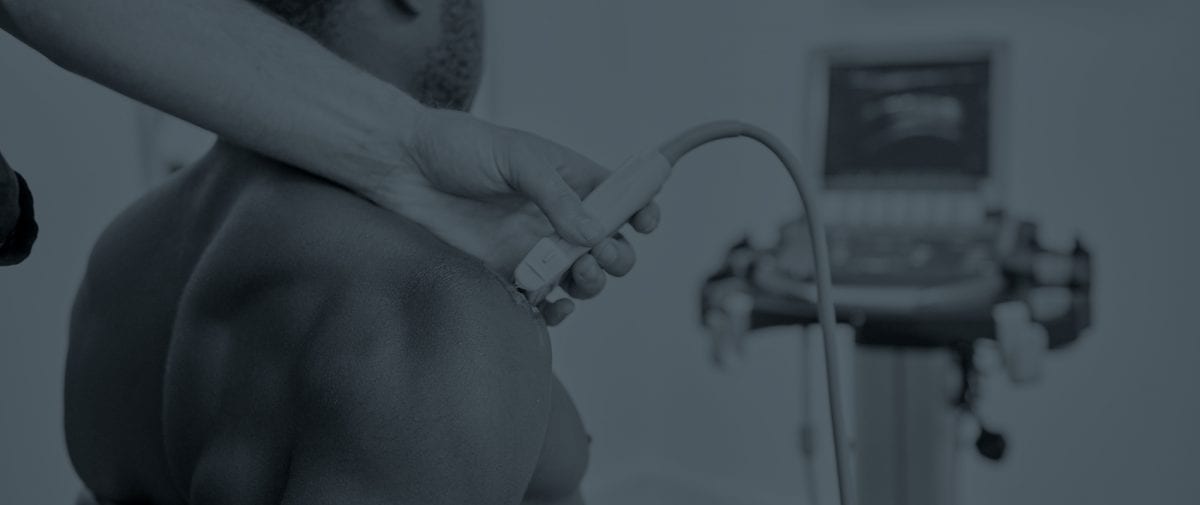Hydrodistension, hydrodilatation or High Volume injections are performed under ultrasound guidance with the aim of precisely depositing anti-inflammatory steroid, local anaesthetic and saline to give pain relief whilst also deliberately stretching the lining of the joint (joint capsule). This procedure is increasingly used in the treatment of ‘frozen shoulder’ (adhesive capsulitis) and has been shown to be effective in the majority of patients by giving pain relief and also helping them to regain movement. These injections can give a rapid and effective reduction in pain and inflammation; however, improvements are usually temporary. As with all medicines, some people may experience side effects. This patient information leaflet aims to provide you with the information that you need to know.
What are steroids, and how is a steroid injection used?
Some steroids occur naturally in the human body, and man-made steroids act like natural steroids to reduce inflammation. They are not the same as steroids used by bodybuilders to increase muscle size and strength. They can be taken as tablets or as an injection.
Steroids are often recommended for people with inflammatory conditions and musculoskeletal pain, such as inflammatory arthritis. They can also be used in osteoarthritis and a range of other soft tissue conditions which involved pain and/or inflammation.
A range of different steroids exist, some are shorter acting which works almost immediately, but they only give short-lived relief maybe a week or so. Longer-acting steroid takes around a week to work but can last for several months.
What happens when I have a hydrodistension injection?
The clinician who will be performing your injection will choose the most appropriate steroid medicine and overall volume dose for your condition and symptoms. You will normally be lying down for the injection with the joint exposed. The clinician will inject under ultrasound guidance directly into the joint. Most injections are quick and easy to perform.
Some patients opt to have a smaller dose steroid injection immediately after there hydrodistension injection into an area around the joint known as the ‘bursa’. There is some research to support that this gives a significant amount of further pain relief. Having this additional procedure can be discussed with you are treating clinician on the day.
For safety reasons, your clinician may delay your injection if you have unstable blood pressure or unstable blood sugars due to diabetes to get consent from your GP.
What happens after the injection?
Due to the local anaesthetic, some of your pain may be relieved shortly after the injection but will probably wear off after a few hours. It usually takes several days for the effect of the steroid to fully begin to work.
You may wish to arrange transport home after your injection as we would not recommend for you to drive immediately after a hydrodistension procedure as some people may experience some post-injection discomfort due to the stretching of the joint. Occasionally patients may feel a little lightheaded immediately afterwards. We recommend staying in the waiting area for 20-30 minutes following the injection.
You should try to avoid strenuous exercise for 3-5 days after the injection but try to perform some regular stretches as advised by your physiotherapist from 24hours after your injection. If you do not already have an exercise and stretching program, this will be provided for you following the procedure.
Will I need another injection?
If you find the injection helpful, and you feel further injections are required, this may be repeated. We usually recommend a period of 1 month between these injections. We usually recommend no more than 3 injections into any one location within a 12 month. Injections are most often used to provide a period of reduced pain in order to engage in exercise and rehabilitation. Once your pain is better controlled, the need for injection should be reduced.
Possible risks and side effects
Most people have hydrodistension injections without any significant side effects.
The risk of side effects is greater with stronger doses and longer-acting steroids, such as Triamcinolone acetonide and Methoprednisolone, as they tend to be stronger and dissolve less easily in your body. However, these steroids are often preferred as they offer longer treatment affects.
Will it hurt?
They can be a bit uncomfortable at the time of injection, but many people find that they are not as bad as feared. With hydrodistension exercises, the aim is to deliberately stretch the capsule (lining) of the joint this may cause some discomfort at the time of the injection that usually resolves shortly afterwards.
Flare-up of pain
Occasionally people may notice a flare-up of their pain within the first 24-hours after injection. This usually settles itself within a couple of days. Simple painkillers, such as Paracetamol, may help.
Skin changes
Injections containing steroid can occasionally cause some thinning and changes in the colour of the skin (local depigmentation) at the injection site. In rare cases, a steroid injection into muscles or joints can cause an indentation (fat atrophy) in the skin around the area.
Infection
Very rarely, you may get an infection in the joint at the time of injection. If the joint becomes more painful and hot, you should seek medical attention immediately, especially if you are also feeling generally unwell.
Weight gain
People are often concerned around the possibility of steroid-related side effects, such as weight gain. One of the advantages of steroids, compared with tablets, is that the dose can be kept low. This means the chances of these more systemic side effects are very rare.
Diabetes
People with diabetes may experience a fluctuation in their blood sugars. This should always be discussed with your GP and the therapist providing the injection before the injection takes place. It is important that you be vigilant of your blood sugars for around a week to two weeks after the injection. If you are worried, you should speak to your doctor.
Other possible side effects
Other possible side effects include facial flushing, temporary changes in menstruation and mood.
Can I take other medicines along with the hydrodistension injection?
You can take other medicines with hydrodistension injections, however as they contain steroid, treatment for certain conditions such as diabetes, cancer or HIV may require your therapist to first check with your GP or treating consultant. For example, if you are taking a blood-thinning drug (also called anticoagulants) such as Warfarin, you may need a blood test to make sure that your blood is not too thin to have the injection. This is because of the risk of bleeding into the joint.
You, therefore, must tell the physiotherapist giving the injection if you take anti-coagulants as they may need to discuss this with your GP before giving you the injection.
Pregnancy and breastfeeding
Unfortunately, we are not able to offer hydrodistension injections to patients who are pregnant. If you are currently breastfeeding, please ask your therapist for a leaflet produced by Breast Feeding Network in 2014, which has been produced to give you guidance in this area.
Below is a summary of risks or side effects from having hydrodistension injections
Potential side effects of the steroid
Serious side effects are rare and include:
• Joint and soft tissue infections (Advise on symptoms of septic arthritis and to seek medical advice if they occur)
• Anaphylaxis
Other potential side effects include
• Risk of tendon rupture
• Local subcutaneous fat atrophy (usually temporary and disappears within a few months)
• Local depigmentation (usually temporary and disappears within a few months)
• Post injection flare of pain at the injection site.
• Destabilisation of blood sugars in diabetic patients which require vigilant monitoring by the patient following injection
• Facial flushing
• Menstrual irregularities
• Dizziness
• Injury or trauma to neurovascular structures during the injection procedure
• Very rarely significant joint destruction or damage can occur although usually associated with overly frequent high dose injections
Potential side effects of the local anaesthetic
Serious side effects are rare and include:
• Infection – Infection in soft tissue or joint injected (Advise regarding symptoms of septic arthritis and to seek medical attention)
• Anaphylaxis
Other potential side effects include:
• Lightheadedness
• Numbness of area injected
• Dizziness, drowsiness
• Blurred or double vision
• Vomiting
• Bradycardia
• Hypotension cardiac arrest
• Very rarely loss of consciousness, respiratory depression, respiratory or cardiac arrest.
• Allergic or anaphylactic reaction
• Injury or trauma to neurovascular structures during the injection procedure
Potential side effects due to the high volume used in hydrodistension injections
• Due to the physical distension of the joint capsule patients are more likely to experience some post-injection pain
• Occasionally there may be some degree of rupturing to the joint capsule, this is not usually painful and is often associated with improved range of motion after the injection.
You will be asked to remain in the clinic waiting area for 20-30 minutes following the injection to allow observation of possible adverse reactions.
Your therapist is trained to and will take every appropriate step to avoid injecting or traumatising soft tissue structures, nerves or vessels when performing the injection. However, there is a very small risk that this can occur, particularly with injections at certain locations
Learn more
Don’t let pain hold you back, book now!







